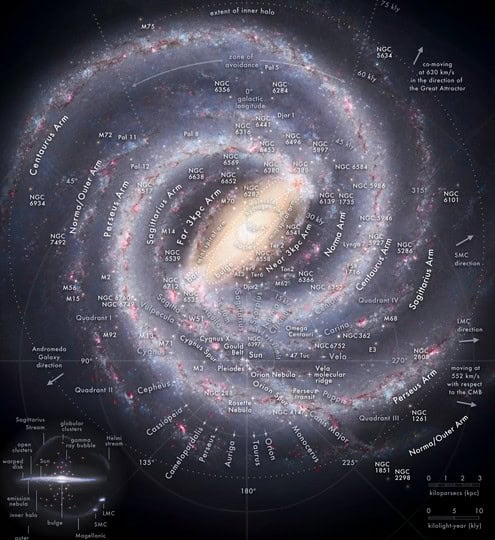
Currently, there are 58,742 educational establishments that provide extra cumulative discounts ranging from 2% to 25%. To discover the available discount for all staff members of your educational institution, please access your personal Infoworks account.


Course for professional growth
Current challenges in teaching specialized piano at Children’s and Youth Music Schools and Children’s High Schools of Music
In addition to this promotion, we can offer a discount for your educational institution (the discount amount depends on the number of your colleagues who have enrolled in Infoworks courses).
Currently, we are providing additional cumulative discounts (ranging from 2% to 25%) to 58,742 educational institutions. To discover the discount available for all members of your educational institution, please log in to your personal Infoworks account.


Enroll in our professional retraining course today!
Establishing a quality management system for vocational education institutions
We are pleased to offer an exclusive discount to your educational institution. The amount of this discount depends on the number of your colleagues who have completed Infoworks courses.
Currently, 58,742 educational institutions are benefiting from additional discounts ranging from 2% to 25%. To find out the discount available to all employees of your educational institution, simply login to your personal Infoworks account.


Special features of teaching Russian literature in schools with consideration of the new Federal State Educational Standard for General Education
Description of the presentation using separate slides:


2 slide In 1609, when the brilliant Italian scientist Galileo Galilei became the first person to direct a telescope towards the heavens, he made an astounding revelation: he unraveled the mystery of the Milky Way. Using his rudimentary telescope, he was able to differentiate the brightest clusters within the Milky Way into individual stars! However, he also observed fainter clouds behind them, which he couldn’t fully understand at the time, although he correctly deduced that they too must be composed of stars. Presently, we are aware that his hypothesis was accurate.


Slide 3: The Milky Way galaxy is composed of approximately 200 billion stars. Our solar system, including the Sun and its planets, is just a tiny fraction of this vast collection. In fact, our solar system is only about two-thirds the size of the Milky Way galaxy. We are located on the outskirts of our galaxy, living in its outer regions. The Milky Way has a circular shape, with denser clusters of stars at its center. As you move towards the outer edges of the galaxy, the stars become less dense and the galaxy appears flattened, resembling the rings of Saturn when viewed from the outside.

Slide 4 Gas Nebulae
It was later revealed that the Milky Way is not solely composed of stars, but also contains gas and dust clouds that move slowly and in a random manner. However, these gas clouds are only found within the disk. Some gas nebulae emit a colorful light. One of the most well-known is the Orion Nebula, which can even be seen with the naked eye. Presently, we are aware that these gas or diffuse nebulae serve as the birthplaces of young stars.



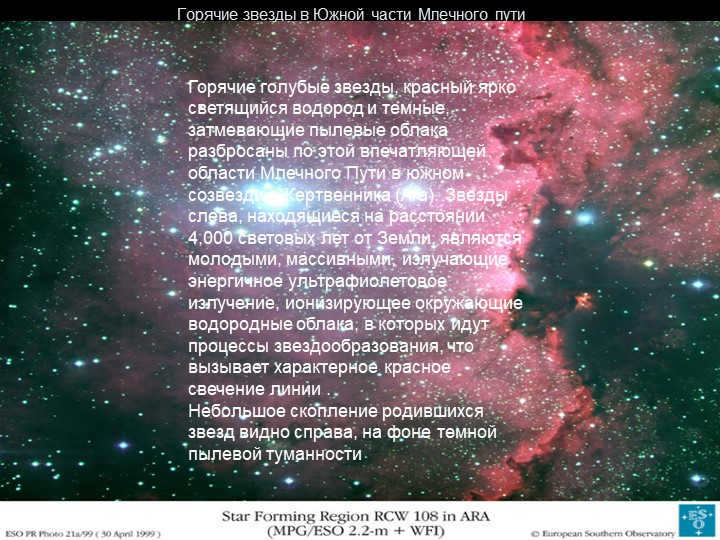
Slide 7: Exploring the Southern Part of the Milky Way
The southern part of the Milky Way is home to a stunning array of celestial phenomena. Hot blue stars, vibrant red hydrogen emissions, and mysterious dark dust clouds can be found throughout this captivating region, which lies within the constellation of Ara. On the left side of the image, we can observe a group of young, massive stars situated 4,000 light-years away from Earth. These stars emit powerful ultraviolet radiation that ionizes the surrounding hydrogen clouds, resulting in the distinctive red glow.
On the right side, we can see a small cluster of newborn stars, set against the backdrop of a shadowy dust nebula.

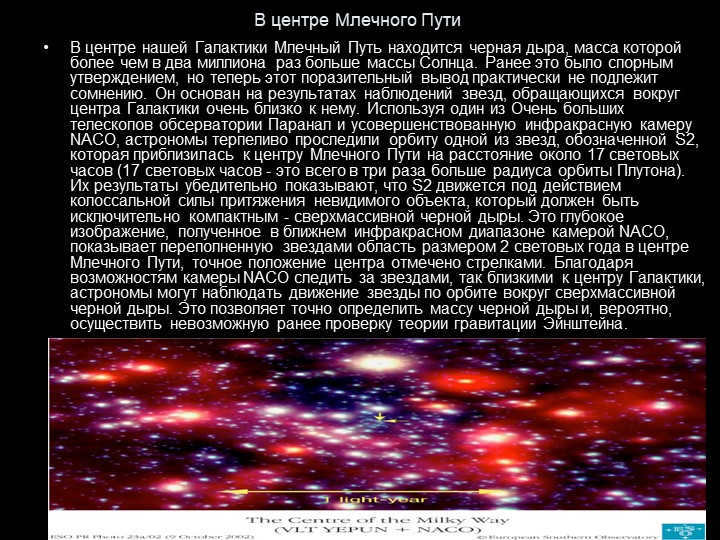



Slide 12: A Cosmic Encounter as the Miley Way Converges with a Distant Galaxy
Recent astronomical research suggests that billions of years ago, our Milky Way galaxy had a cosmic encounter with another galaxy, leaving behind remnants that still exist in the Universe. By studying approximately 1,500 sun-like stars, an international team of scientists has determined that the trajectory and positioning of these stars provide evidence of this celestial collision. “The Milky Way is a vast galaxy that we believe formed through the merging of multiple smaller galaxies,” said Rosemary Wyse, a researcher from Johns Hopkins University. Wyse and her colleagues from the United Kingdom and Australia have been focusing their observations on the outskirts of the Milky Way, where they believe signs of past collisions may be found. Preliminary analysis of their findings has confirmed their hypothesis, and further investigation (which aims to study around 10,000 stars) will provide a more precise understanding. It is worth noting that collisions that occurred in the past could potentially happen again in the future. In fact, calculations suggest that in billions of years, the Milky Way and Andromeda, the nearest spiral galaxy to us, may collide.


According to Dr. Merit, it is widely accepted that a black hole exists at the core of most galaxies. The problem lies in understanding what happens when galaxies collide and merge. During this process, a larger black hole is formed as smaller black holes combine. The merger also results in the absorption and expulsion of stars located near the center of the galaxies. Observations of nearby interacting galaxies provide support for these theoretical models. Unfortunately, the current computing power has not been sufficient to construct a numerical model for testing these theories. This marks the first opportunity to do so.
Looking ahead, the astrophysicists at RIT will focus on investigating the movements of stars in the central regions of our own galaxy, the Milky Way. This research aims to shed light on the formation of black holes at the center of our galaxy.
According to Dr. Merit, the installation of one of the world’s most powerful computers will not only help solve large-scale problems in astronomy, but also position Rochester Institute of Technology as a leader in various scientific fields. Currently, the most powerful supercomputer is the BlueGene/L, developed by IBM and housed at the Lawrence Laboratory in Livermore, USA. With a current speed of 136.8 teraflops, this supercomputer is expected to double its performance once it is fully configured with 65536 processors.

Slide 15: The Milky Way System
The Milky Way System is a massive star system, also known as a galaxy, that the Sun is a part of.
Within the Milky Way system, there are numerous stars of different types, along with star clusters and associations, gas and dust nebulae, and individual atoms and particles scattered throughout interstellar space. The majority of these entities are located within a lens-shaped region that spans approximately 100,000 light-years in diameter and is about 12,000 light-years thick. The remaining portion fills a nearly spherical region with a radius of about 50,000 light-years.
The Galaxy is comprised of various elements that are interconnected to form a unified and dynamic system, which revolves around a central axis of symmetry. The focal point of this system lies in the direction of the Sagittarius constellation.

According to the estimation made through the use of radioisotopes, the age of the Milky Way is determined to be 16 slide.
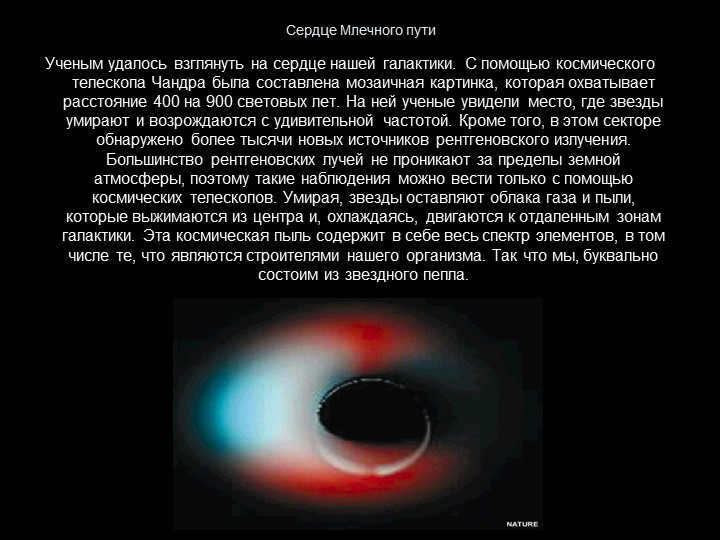
Slide 17: Exploring the Core of the Milky Way Galaxy
Researchers have recently gained a rare insight into the heart of our very own galaxy. Utilizing the high-powered Chandra Space Telescope, they were able to create a captivating mosaic image spanning an impressive distance of 400 by 900 light-years. Within this image, scientists observed a region where stars undergo a fascinating cycle of birth and death. Furthermore, over a thousand novel sources of X-ray radiation were detected in this particular sector. Due to the limited ability of X-rays to penetrate Earth’s atmosphere, these observations can only be made using space telescopes. As stars reach the end of their lifecycle, they release clouds of gas and dust that are pushed outward from the center and eventually cool down, drifting into the far reaches of the galaxy. Within this cosmic dust lies a wide array of elements, including the very building blocks of life. In essence, we are composed of the remnants of long-departed stars.



Currently, there are additional cumulative discounts (ranging from 2% to 25%) offered to 58,742 educational establishments. To determine the applicable discount for all staff members of your educational institution, please sign in to your personal Infoworks account.


Advance your skills with our professional development course
Become an expert in occupational safety
We offer the opportunity to apply your educational institution’s discount in addition to our regular discounts. The amount of discount depends on the number of colleagues from your institution who have already enrolled in Infoworks courses.
Currently, 58,742 educational institutions are benefiting from our additional discounts ranging from 2% to 25%. To find out what discount is available for all employees of your educational institution, simply log in to your personal Infoworks account.


Get professionally retrained with our courses.
Learn about managing electronic services for archives, libraries, and information-library centers.
We offer discounts for educational institutions. The discount amount depends on the number of colleagues from your institution who have taken Infowork courses.
Currently, 58,742 educational institutions are benefiting from additional discounts ranging from 2% to 25%. To find out the discount available for all employees of your educational institution, simply log in to your personal Infoworks account.


Unique Characteristics of Educational Requirements for Young Children and Preschoolers with ZPD
Breakdown of the Presentation by Each Slide:

We will be covering the following topics in this lesson:
the definition of a constellation; what constitutes a galaxy; the concept of a light year.
Additionally, we will discuss the total number of constellations visible in the night sky, the origins of their names, and zodiacal constellations.
Geography teacher Zaitseva K.M.
BOU “Frolovskaya Secondary School”.


Slide 2: Identify the traits that correspond to the Sun and the Earth.
1. Spherical shape.
2. Source of light and heat.
3. Does not emit its own light and heat.
4. A planet.
5. A glowing celestial body.
6. Located at the center of the solar system.
7. Rotates on its axis.
8. Moves around the center of the solar system in its orbit.
9. The change of seasons is observed.
10. A star.
11. There is a change of day and night.
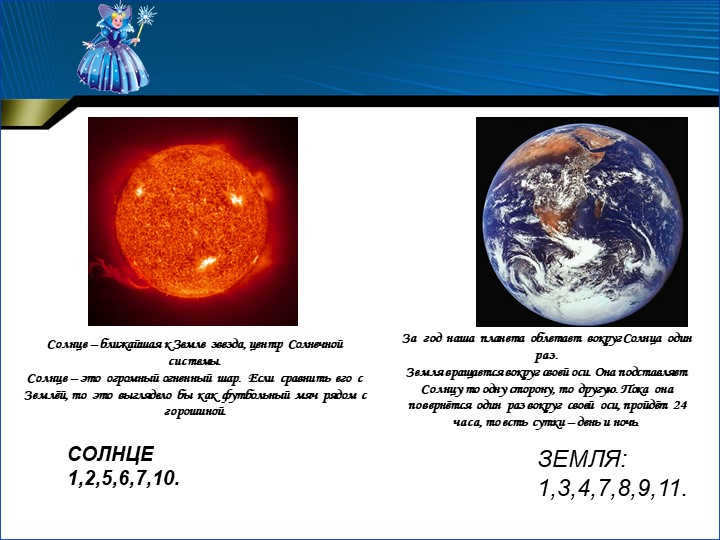

EARTH:
1,3,4,7,8,9,11.
The Sun is the nearest star to Earth, which is located at the center of our solar system.
The Sun, a massive ball of blazing fire, dwarfs the Earth in comparison. It would be like comparing a soccer ball to a tiny pea.
Over the course of a year, our planet completes one orbit around the Sun.
As the Earth rotates on its axis, it experiences day and night. One side of the Earth faces the Sun while the other side remains in darkness. A full rotation takes 24 hours, resulting in the cycle of day and night.


Slide 4 Stars are enormous radiant spheres similar to the Sun. They are situated at a considerable distance from the Earth, resulting in them not providing warmth and appearing very small.
In the nighttime sky, stars shimmer in a variety of colors: blue, white, yellow, red. White and blue stars are extremely hot. Red stars are the least warm among stars.


Slide 5 Stars, stars, from time immemorial.
You have perpetually captivated humanity’s insatiable stare.
And as he sat on animal hide
Next to the glowing fire,
He could gaze uninterrupted at the azure sky
He could gaze at the azure sky until dawn.

Slide 6 The celestial heavens have always captivated the human mind.
-What is the reason behind the stars’ illumination?
-How numerous are the stars that twinkle at night?
-What is the distance between us and them?
-Is there a limit to the vastness of the stellar Universe?
Since ancient times, humans have pondered over these and numerous other inquiries, endeavoring to comprehend and unravel the structure of the immense world in which we reside.

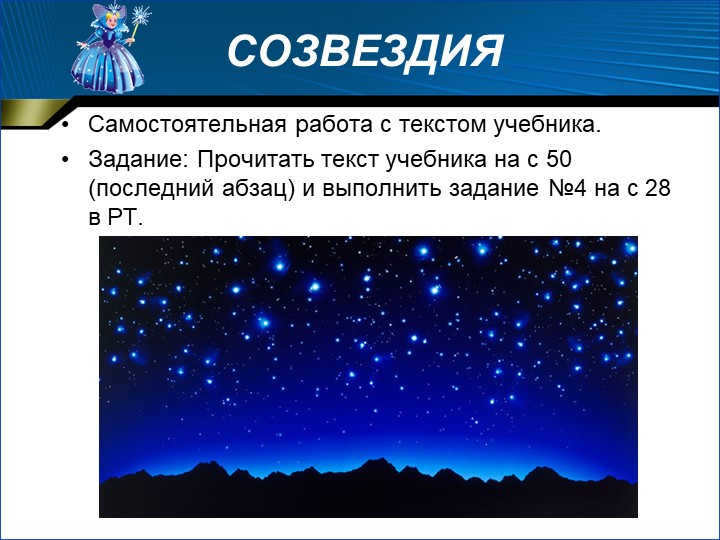
slide 8 stars
Engage in individual work with the text from the textbook.
Objective: Go through the text from page 50 (the final paragraph) in the textbook and complete task number 4 on page 28 in the reading taskbook.


Slide 9: Constellations
In previous times, constellations were commonly referred to as figures of bright stars.
These figures were known as constellations.
However, in present times, scientists identify them as constellations.
The entire sky is divided into a total of 88 constellations.
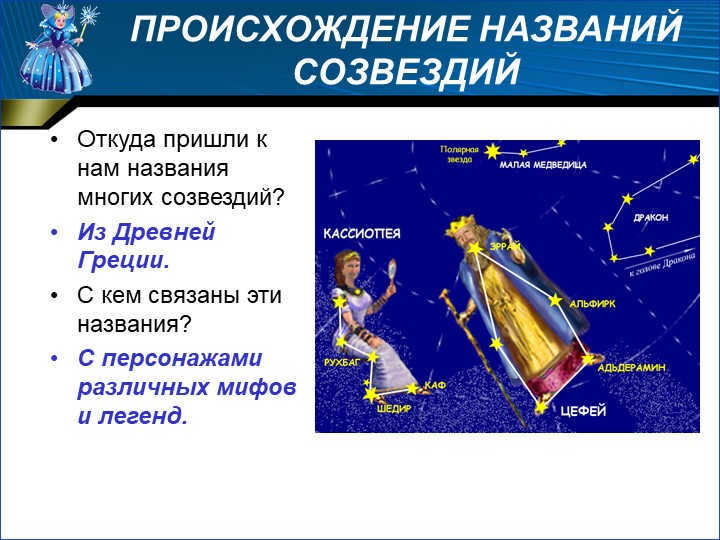

Slide 10 – The Origins of Constellation Names
What is the source of the names for numerous constellations in our galaxy?
They come from ancient Greece.
To whom are these names linked?
They are associated with characters from various myths and legends.
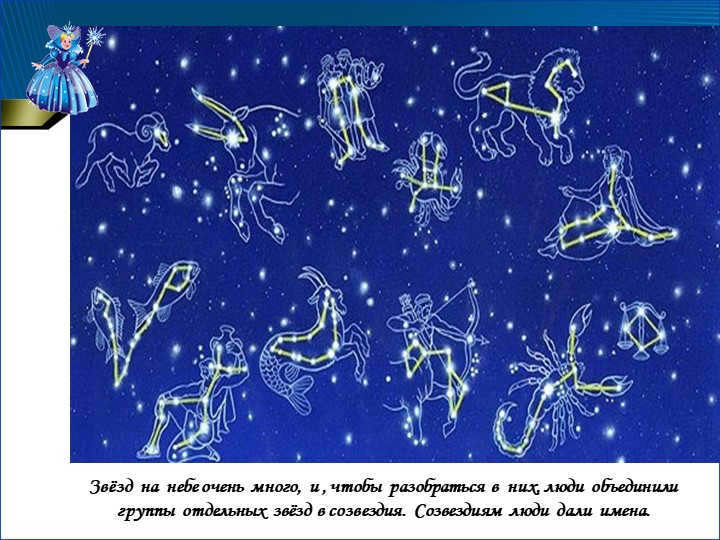

11 slide The sky is filled with an abundance of stars, and in order to comprehend their vastness, individuals have come together to form constellations. These constellations have been given names by people.
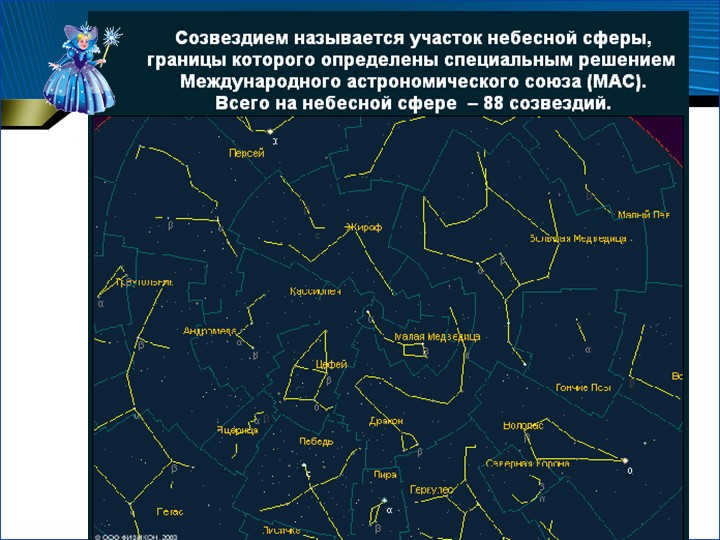

Slide 14: The Tale of Big Bird.
There are numerous myths surrounding the Great and Small Bears.
Allow me to share one with you. Once upon a time, in a distant past, the monarch who governed the land of Arcadia had a daughter called Callisto.
Her beauty was so remarkable that she dared to challenge Hera – the goddess and spouse of the mighty supreme deity Zeus.
Envious Hera eventually sought retribution against Callisto: utilizing her divine abilities, she transformed her into a hideous bear.

15 slide BIG BIRD.
When Callisto’s offspring, the youthful Arcades, happened upon a savage creature lurking at the entrance of his dwelling one fateful day, he nearly slew his own mother, the bear, without suspecting her true identity.
Thankfully, Zeus intervened, grasping Arcades’ hand and forever preserving Callisto’s existence by transforming her into a resplendent celestial formation known as the Big Dipper.
Simultaneously, Callisto’s beloved canine companion was also transfigured into the Little Dipper.
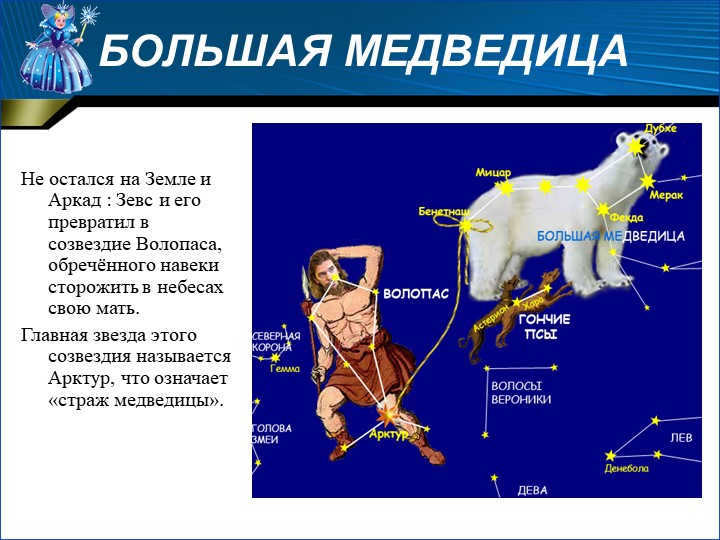

slide 16 The Big Dipper
Arkad did not stay on Earth: Zeus turned him into the constellation Volopas, destined to forever protect his mother in the skies.
The primary star in this constellation is known as Arcturus, signifying the “bear guardian”.

slide 18 DOCTORS
There was an astronomer on the lunar surface
He monitored the celestial bodies:
MERCURY – single,
VENERA, double,
Three, EARTH,
Four, MARS,
Five, Jupiter,
Six, SATURN,
Seven, Uranus,
Eight, Neptune,
Nine is the most distant
PLUTON,
Who is imperceptible, leave!
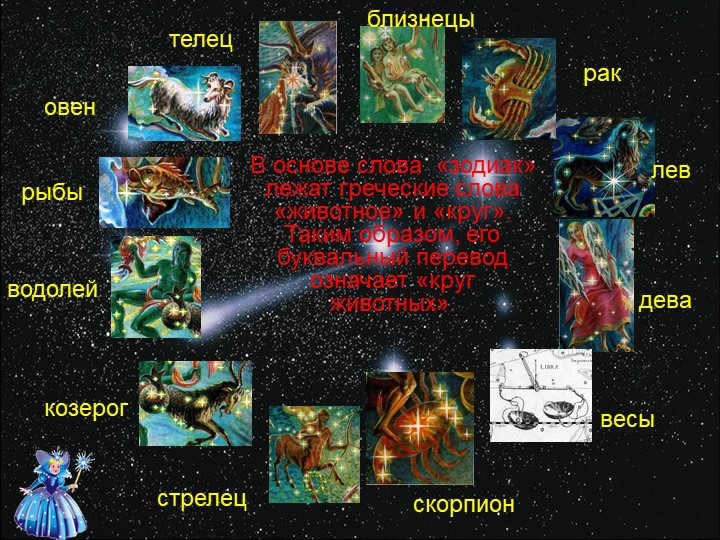
slide 19 Aquarius
Leo
Cancer
Capricorn
Gemini
Taurus
Sagittarius
Aries
Pisces
Virgo
Libra
Scorpio
The term “zodiac” originates from the Greek words meaning “animal” and “circle”.
Therefore, its literal translation is “circle of animals”.

There are 20 slides about GALACTICS.
A galaxy is an immense assemblage of stars, interstellar gas, dust, and dark matter that are held together by the forces of gravitational interaction. Generally, galaxies consist of 10 million to several trillion stars that revolve around a shared center of gravity. Besides individual stars and a sparse interstellar medium, most galaxies also contain multiple star systems, star clusters, and various nebulae. Normally, galaxies have diameters that range from a few thousand to a few hundred thousand light-years, and the distances between galaxies are measured in millions of light-years.
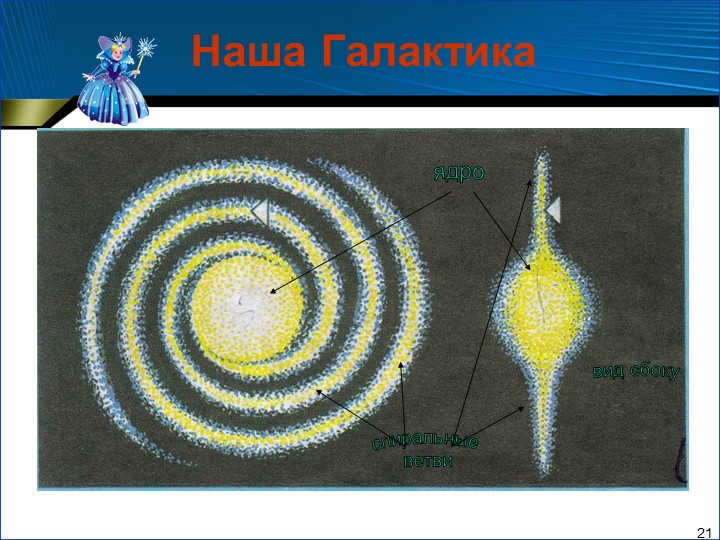
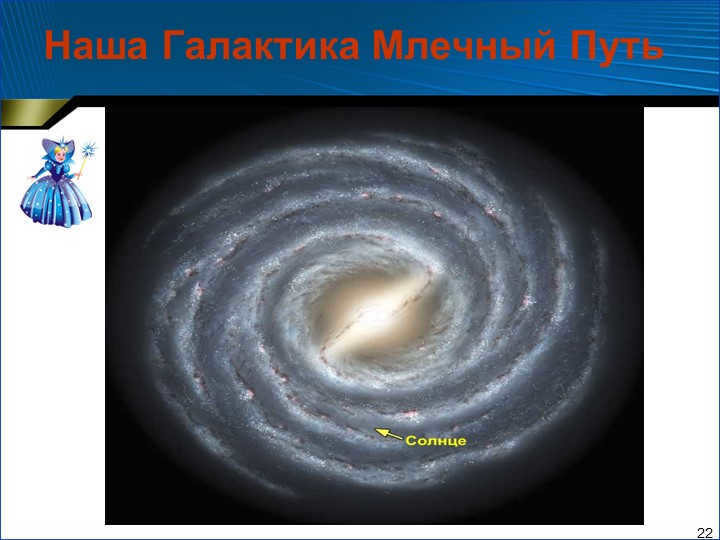

A light-year represents the distance covered by light over the course of a year.
Light travels at a speed of 300,000 kilometers per second.
Over the span of a year, light manages to cover a whopping 10 trillion kilometers.
It is interesting to note that the typical gap between stars is approximately 5 light-years, which translates to around 50 trillion kilometers.
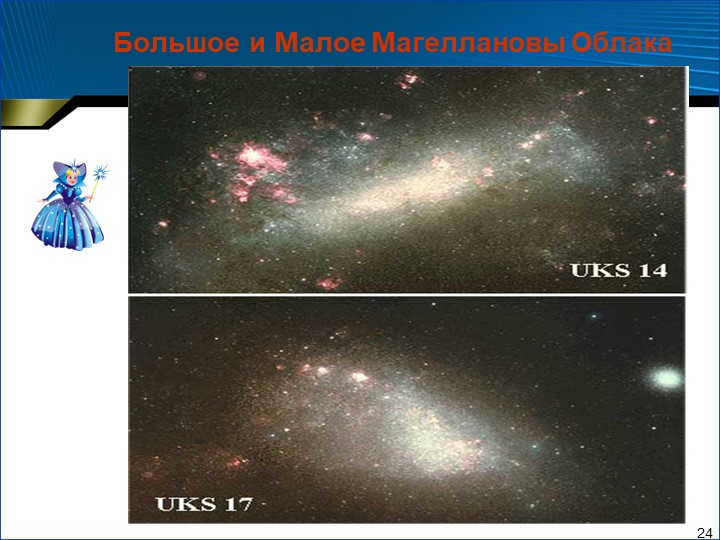
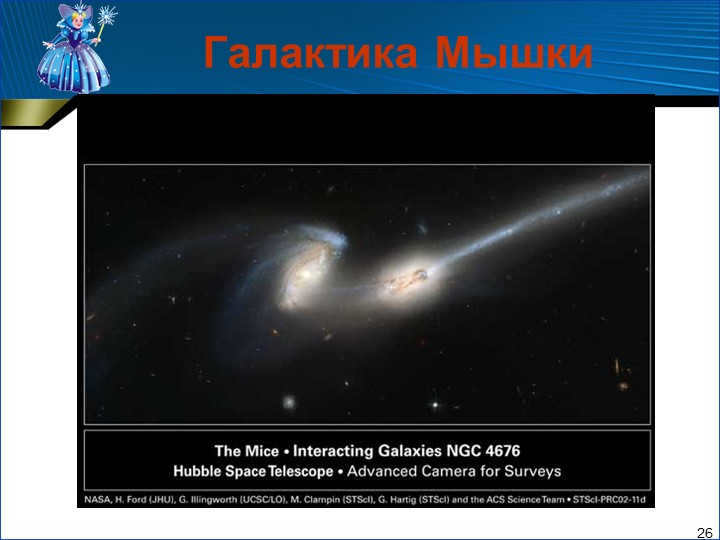
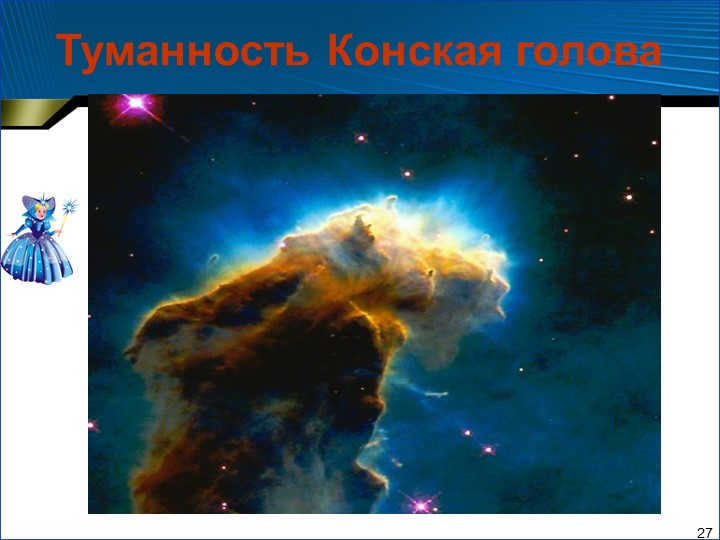
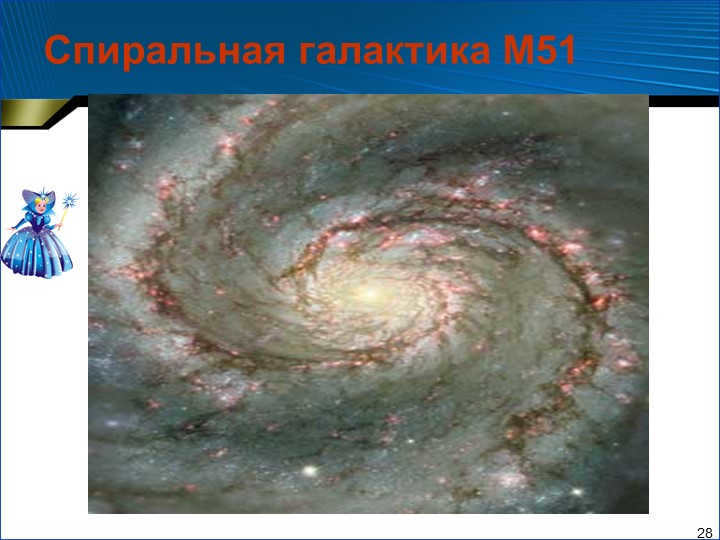

Discover your celestial sign.
Aries March 21 – April 20
Taurus April 21 – May 21
Gemini May 22 – June 21
Cancer June 22 – July 22
Leo July 23 – August 23
Virgo August 24 – September 23
Libra September 24 – October 23
Scorpio October 24 – November 22
Sagittarius November 23 – December 21
Capricorn December 22 – January 20
Aquarius January 21 – February 18
Pisces February 19 – March 20

During the 30th slide of UE-3 REFLECTION, I reflected on what I learned and what I gained from the lesson. I also pondered on how I communicated during the lesson and what feelings arose within me. Additionally, I assessed the significance of the material to me.
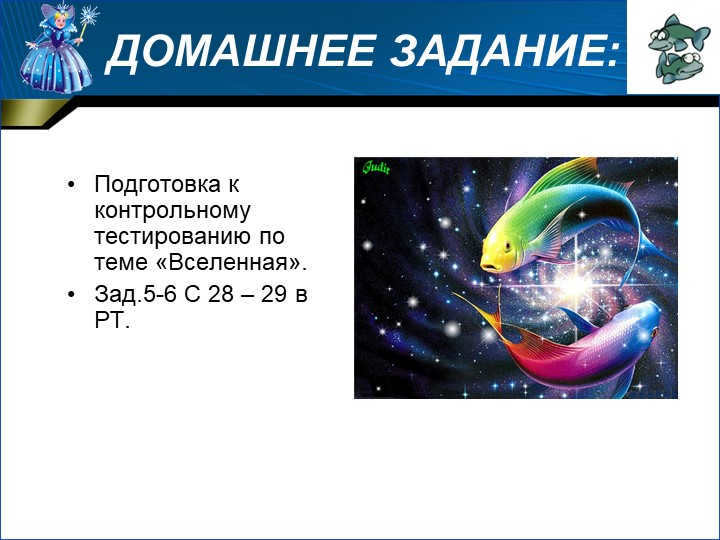

31 slide Homework:
Get ready for a quiz about “The Universe”.
Exercise 5-6 on pages 28-29 in the textbook.
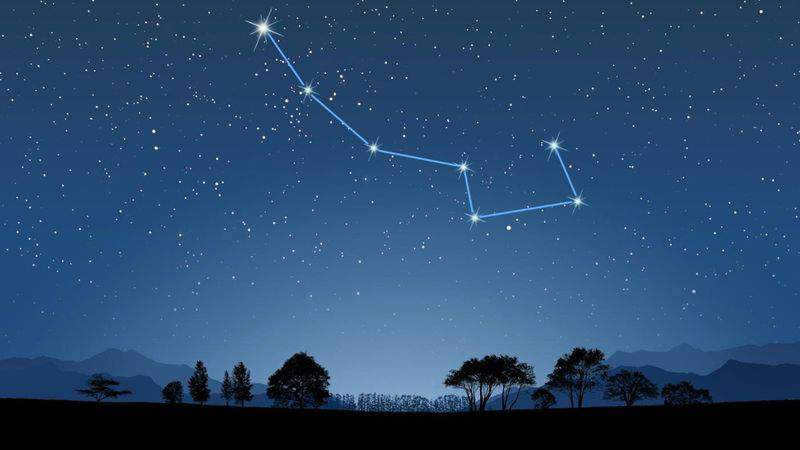
The constellations in our galaxy have a wide range of names, each one unique and diverse. Some of these names date back to Ancient Greece, while others have Arabic origins. The most well-known constellations include those from the zodiacal circle, the Big and Little Bears, the Hound Dogs, and Hydra.
Even before the rise of civilizations on Earth, people had already given names to the bright, large, and beautiful points of light in the night sky. However, not everyone is familiar with the names of these constellations or their fascinating origins. Typically, only the more popular ones are widely known, with some visible on a daily basis and others only appearing during specific seasons.
There is a certain enchantment in the names of celestial bodies. They have often been named after heroes or animals from ancient legends, as the night sky has always held a sense of incredible wonder and beauty.
The celestial sphere in the northern and southern hemispheres is adorned with figures derived from the heroes and gods of Greek epics, and the solar system boasts an astonishing array of stars, zodiacal constellations, and the renowned Big and Little Dipper. Simply perusing a star chart of two latitudes, or gazing at actual photographs or diagrams created by astronomers, makes it abundantly clear just how many marvels exist within our Milky Way. The roster of celestial wonders is continually expanding with new discoveries, as technology advances and delights scientists with its extraordinary findings.
Classification of constellations
The celestial sphere is adorned with 88 ancient stellar bodies. They are grouped and classified by various categories:
- mythological: Cassiopeia, Hercules, Unicorn;
- animals, birds, zodiacal names: Big and Little Dippers, Virgo, Lizard, Eagle, Scorpion, Wolf, Aries, Hare;
- instruments, objects: Lyre, Cup, Scales, Compass, Circulus;
- geometric: triangle, grid.
Under certain conditions and from different points on Earth, a person can observe approximately 6,000 stars. Each star has its own scientific designation! However, only about 300 of them have additional personal names that have been passed down from antiquity. These names often originate from Greek, Latin, and Arabic. The Arabs discovered new stars and renamed existing celestial bodies.
It is a well-known fact that the stars, much like the sun, have a journey across the sky. They follow their own unique path. These celestial movements help us mark the transition from one season to another, especially when the weather or natural cues are not able to convey it.
The names of stars have been documented on maps since ancient times, dating back to the era of ancient Babylon. There are historical records indicating that early humans even depicted stars on the walls of caves, such as the famous Lascaux cave in southern France.
In 1929, the Moscow Astronomical Union established a comprehensive list of 88 stars that span the entire celestial sphere.
The Solar System’s Zodiacal Constellations
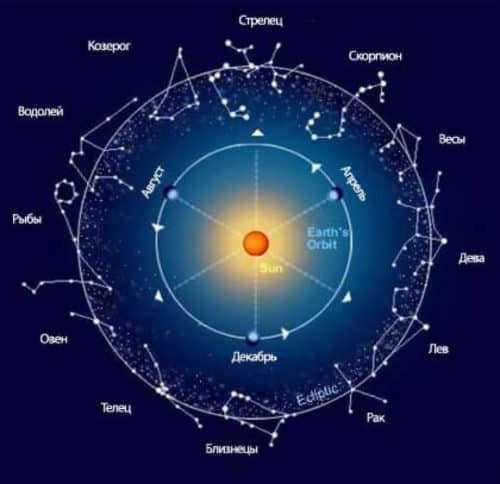
There are a total of 13 star formations in the zodiac circle:
- The first is Aries;
- The second is Taurus;
- The third is Gemini;
- The fourth is Cancer;
- The fifth is Leo;
- The sixth is Virgo;
- The seventh is Libra;
- The eighth is Scorpio;
- The ninth is Sagittarius;
- The tenth is Capricorn;
- The eleventh is Aquarius;
- The twelfth is Pisces;
- And finally, the thirteenth is Serpentine.
All of the planets, the Sun, and the Moon follow their own paths in the sky, just as the Earth spins on its own axis. As they travel, they pass through each of these 13 celestial bodies, which are known as the zodiac signs.
| Aries | Ari | 19.04-13.05 | 25 days |
| Taurus | Tau | 14.05-19.06 | 37 days |
| Gemini | Gem | 20.06-20.07 | 31 days |
| Cancer | Can | 21.07-9.08 | 20 days |
| Leo | 10.08-15.09 | 37 days | |
| Virgo | Vir | 16.09-30.10 | 45 days |
| Libra | Lib | 31.10-22.11 | 23 days |
| Scorpio | Sco | 23.11-29.11 | 7 days |
| Serpentine | Oph | 30.11-17.12 | 18 days |
| Sagittarius | Sgr | 18.12-19.01 | 32 days |
| Capricorn | Cap | 20.01-15.02 | 28 days |
| Aquarius | Aqr | 16.02-11.03 | 24 days |
| Pisces | Psc | 12.03-18.04 | 38 days |
When making predictions, astrologers rely on the 12 signs of the zodiac, which are distinct from the star patterns of the same name. It is important to note that astrology is not considered a scientific discipline, unlike astronomy.
The star formations of the Big Dipper and Little Dipper
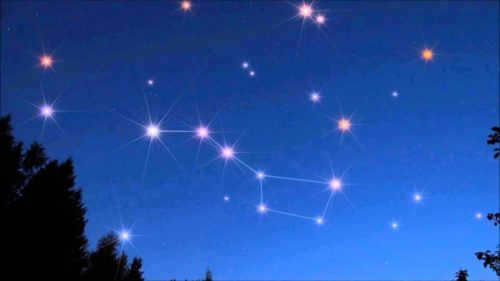
These constellations are among the most easily recognizable star clusters in the Northern Hemisphere. From a young age, children are taught about these celestial bodies. Look up at the sky and you’ll see the iconic bucket-shaped formations known as the Big and Little Dipper. These constellations rank third in terms of size.
The Big Dipper is made up of 125 stars, all of which can be seen with the naked eye if you know where to look. Each star has its own unique name. The lineup starts with Virgo and Hydra. Some of the most well-known stars in the Big Dipper include:
- Dubhe (meaning “bear”), which is the brightest;
- Merak (meaning “loins”);
- Thekda (meaning “thigh”);
- Megretz (meaning “beginning of the tail”);
- Aliot (meaning “curd”).
- Mitzar (“loincloth”);
- Benetnash (“leader of the mourners”).
The position of the Big Dipper varies throughout the year, as well as at different times of the day. The 5 stars in the constellation form their own distinct group and move independently from the rest. It is possible that the pattern of the Little Bear will completely change in the future.
The Little Dipper consists of 25 stars. Some of the most well-known stars in the constellation include:
Primary and secondary star formations
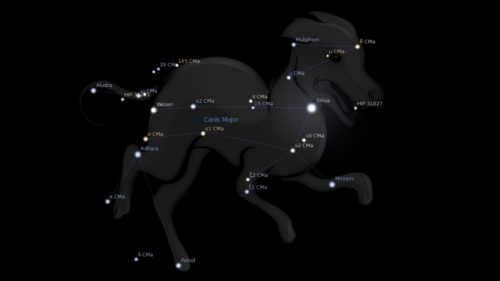
There is currently a wide range of constellations, varying in size, that are well-known.
One of the largest constellations is Hydra. It received its name due to its extensive size, as it stretches across approximately a quarter of the entire sky. However, it is not particularly bright, with only Alfard and Gamma standing out in terms of brightness.
Virgo, on the other hand, is slightly smaller in size compared to Hydra.
The Southern Cross is one of the smallest constellations in the southern hemisphere. It bears a resemblance to the Big Dipper, with a size of 68 degrees. Prior to 1589, it was considered part of Centauri, but it has since been recognized as a separate constellation.
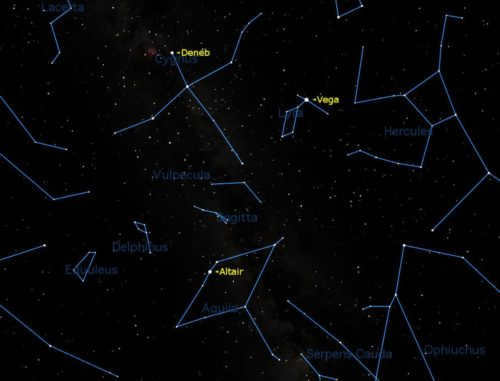
The pattern of stars changes as the Sun moves in a circular motion.
| Time of year | Seasonal constellations | Brightest stars |
| Autumn | Cygnus; |
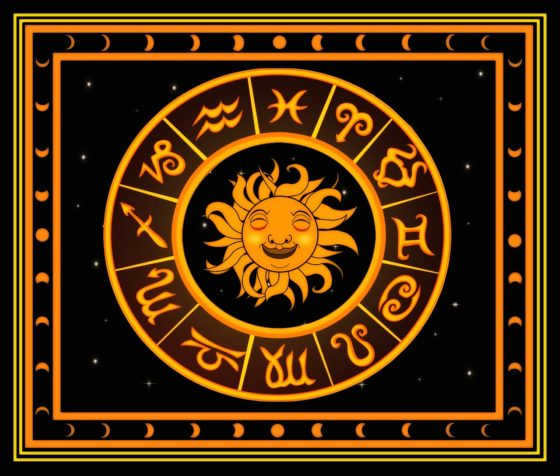
Constellations are regions that divide a map of the celestial sky. In ancient times, constellations were referred to as formations created by groups of stars.
For the purpose of navigation, stars were grouped together into sectors. The concept of constellations emerged in the 2nd century BC and served as the foundation for the first celestial maps.
The division was arbitrary and did not imply any connection between the stars within a constellation. It was common for one group of stars to be included in another, and certain areas of the sky with fewer stars were not assigned any constellations at all.
The division resulted in some regions having stars belonging to two or even three constellations, while others remained unoccupied or “homeless”. In the early 19th century, borders were introduced on the starry sky map to fill these empty areas. However, there was still no official and universally accepted delineation.
In July 1919, the International Astronomical Union (IAU) was established in Brussels, serving as an organization dedicated to astronomy and astronautics. Thanks to the efforts of the IAU, the final boundaries of 88 stellar sectors were officially defined and recognized in 1928. This greatly simplified the tasks of cartographers, sailors, astronomers, and promoted better understanding among scientists.
Zodiac Circle
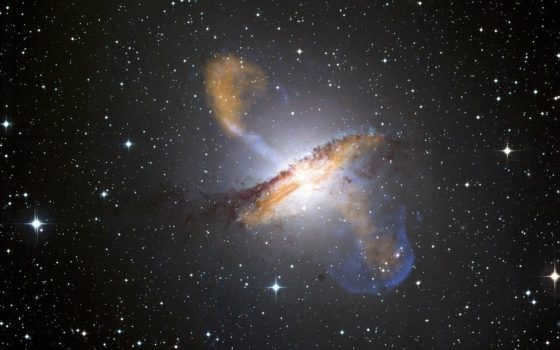
The sky is filled with numerous constellations, including the zodiacal circle. The zodiacal circle consists of a total of 13 constellations, namely Aries, Taurus, Gemini, Cancer, Leo, Virgo, Libra, Scorpio, Sagittarius, Capricorn, Aquarius, Pisces, and Serpentor. Although the latter is not officially recognized as part of the zodiac, it lies along the annual path of the Sun, Earth, and Moon. These constellations are commonly associated with astrological forecasts and charts created by modern astrologers.
After two centuries in Babylon, the 12-sector zodiac and zodiacal horoscopes were already being used.
The official boundaries of each zodiac constellation were established in 1928 during the process of mapping out the entire star chart.
How many constellations are visible in the sky?
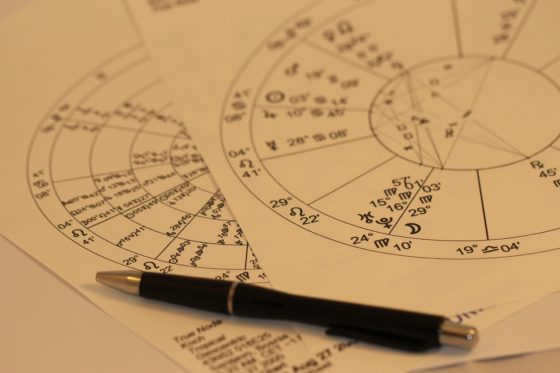
The number of stellar clusters has been in constant flux. For instance, in ancient China during the 4th century BC, there were 122, and in Mongolia during the 18th century, there were 237. Currently, there are a total of 88 constellations. This figure was officially ratified in 1922 at a meeting held by the General Assembly of the International Astronomical Union.
Some of the star groups from the officially approved list have retained their names since the time of the ancient Greeks. Ptolemy’s astronomical work “Amalgest” includes descriptions of 47 constellations, whose names have come down to us. In Russia, only 54 constellations out of the entire collection can be observed.
What is the origin of star group names?
The names of constellations originated from cultural traditions, mythology, and the shapes of objects. Many of the names we use today came from ancient Rome, which in turn borrowed them from the ancient Greeks, who were known to borrow from the ancient Babylonians.
The Babylonian astronomers and astrologers assigned names of mythical heroes, rulers, and animals to groups of stars. The ancient Greeks adopted this system, replacing the Babylonian heroes with their own.
Ancient Rome added to the starry sky by including their own achievements, outstanding personalities, and creatures. This resulted in constellations such as Andromeda, Hercules, Hydra, Cassiopeia, Pegasus, Centaurus, and others.
During the age of geographical discoveries, new constellations like Peacock, Indian, and Bird of Paradise appeared in the sky.
In the modern era, constellations have been given straightforward names that are often associated with animals or instruments. Examples include the Toucan, Microscope, and Compass.
What distinguishes the constellations of the Little Bear and the Southern Cross?
These constellations are famous for their unique characteristics. The Little Bear is visible exclusively in the northern hemisphere, while the Southern Cross can only be seen in the southern hemisphere. Both constellations are easily recognizable and remain relatively stationary in the night sky. This made them incredibly valuable for ancient and medieval navigators, as they provided reliable directional guidance. The quartet of stars in the Southern Cross points to the south, while the Polaris star in the Little Bear indicates the north.
The Obuchonok website offers a wealth of resources for students, including research papers, student projects, creative project ideas, and guidelines for project design. Additionally, educational programs for children are also available on the site.
Banner code:
Research papers and projects
The Milky Way Galaxy

The human race resides within a realm in which its understanding is minuscule. Our comprehension is confined to a limited extent. We inhabit the planet Earth, which is among the eight celestial bodies within the solar system. within the solar system.

It is common knowledge that the Sun is the celestial body on which all life on Earth relies, and that there exist numerous larger stars within our galaxy known as the Milky Way. Altogether, there are several hundred billion stars in the galaxy. Can you fathom a scale where a thousand light years is minuscule, even within our own galaxy?
Fascinating Facts About the Milky Way Galaxy The Milky Way Galaxy, which frequently presents captivating information, is adjacent to the Andromeda Galaxy. Its size is approximately one and a half times greater, and the distance to it is immensely vast.
Is the Milky Way significant or insignificant?
The Universe is home to several tens of billions of galaxies, making the existence of the Milky Way relatively inconsequential on a cosmic scale. Put simply, if the Milky Way were to vanish right now, or even if the entire Solar System were to disappear, it would go completely unnoticed in the grand scheme of the Universe.
When we gaze up at the night sky, we often fail to comprehend the vastness of space that we are witnessing. We are so used to seeing familiar constellations and Earth’s faithful companion, the Moon, but rarely do we stop to consider the enormity of what lies before us.

The dimensions of a few of the constellations within the Milky Way Galaxy
The Great Bear. Most easily spotted during the summer months and identifiable by its unique shape resembling a dipper, it is remarkably vast. During our school years, we were all taught that the distance from the Earth to the Sun is also immense – nearly 150,000,000 kilometers. However, this immensity is rather relative, as it can be compared to mere millimeters in the vastness of outer space.
Just for comparison – the distance between certain visible stars in the Great Bear is thousands of times larger than the distance from the Earth to the Sun! It truly makes one ponder on the vastness of space that we witness in the night sky!
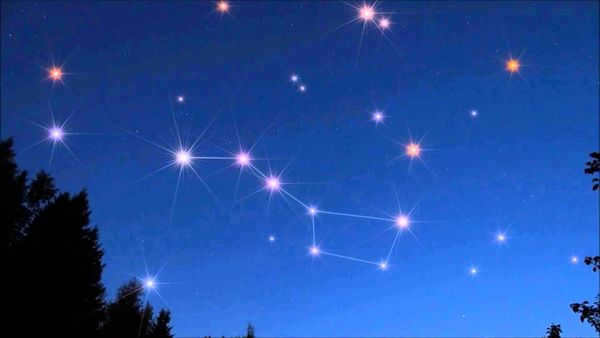
The cosmic peril facing our galaxy
Scientists posit that within each spiral galaxy, such as our very own Milky Way, lies a phenomenon known as a black hole. A black hole is an area of extremely concentrated mass where the laws of physics, as we understand them, cease to hold true. Beyond simply drawing in celestial bodies like comets and asteroids, a black hole has the potential to consume an entire star system!
The mass of the black hole situated in our galaxy is equivalent to 40,000 times that of the Sun, and it spans over a staggering 20,000,000 kilometers.
We are in constant motion, as we move together with the Earth, which in turn moves with the Sun. The Sun itself is part of the Milky Way galaxy, which is also in constant motion within the vast expanse of the Universe. From the smallest atom to the vastness of outer space, everything is constantly rotating and moving.
Exploring distant galaxies
Some may wonder why we should study galaxies beyond our own when there are still so many mysteries to unravel within our own Milky Way. However, it is important to remember that we cannot truly see where we are. By studying neighboring galaxies and observing them from an external perspective, we can gain a deeper understanding of the organization and structure of our own galaxy. These observations continue to reveal fascinating facts about the Milky Way.
Is Catastrophe Unavoidable?
Scientists now hold a strong belief that the Andromeda Galaxy, once thought to be a nebula, is currently on a fast track towards the Milky Way.
It is engulfing and displacing everything in its path, hurtling towards us at a rate of 140 kilometers per second! However, considering the vast distance between our galaxies, this collision will take place millions of years from now, so it seems unlikely that mankind should fear this impending danger.

